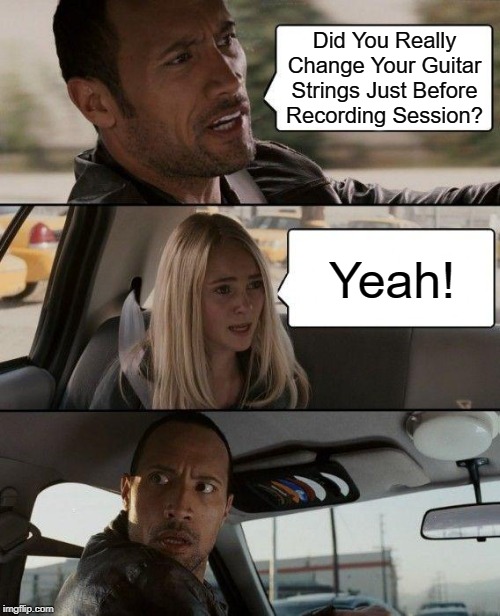How To Buy Acoustic Guitar Strings
Guitarist #1: “I am in search of the perfect, shimmery, bright acoustic guitar tone. What to do?”Guitarist #2: “Upgrade your guitar. Only a quality guitar sounds good. Go with a specific wood. Look for that particular shape. Practise a lot. Play with dynamics........”Guitarist #1: “That sounds like a lot of expense and effort.”Guitarist #2: “Good things don't come easy and cheap.”

1. Understanding String Gauge
-
Light Gauge: - Light gauge strings are thin in diameter. So they are easy to play with and easy to bend, but they break easily. They produce less volume and sustain.
Light gauge strings are more prone to buzzing, especially if you like a low neck action and prefer playing with a rough touch. Light gauges sound a little brighter than medium and heavier gauges. Light gauge strings are a safe choice for old guitars as they apply less tension to the guitar neck.
Gauges like .010 - .048, .011 - .050, and similar are considered light gauges in acoustic guitar strings.
-
Medium/Heavy Gauge: - Medium or Heavy gauge strings are thick and heavy. They have more mass. So they apply more tension to the guitar neck and are hard to play compared to light gauges.
Heavier gauges generate more volume and sustain. They don't break easily and are less prone to buzzing. They are an excellent choice for those who play rough.
Acoustic string’s medium gauges are generally .013 -.056 and similar.
-
Light-Heavy Gauge: - Light-heavy gauges are a combination of light and heavy gauge guitar strings. In modern-day playing, you cannot ignore aspects like string bending and neither can you ignore the good low end. That is why light-heavy gauges are there. They offer you the best of both worlds.
The 1st, 2nd and 3rd strings are of the light gauge, while the 4th, 5th, and 6th strings are of heavier gauges. The 1st, 2nd and 3rd light-gauge strings get you a bright sound and easy playing. The heavy ones produce a more bass prominent tone, great for riffs.
Acoustic string’s light-heavy gauges are .012-.054 and similar.
2. Understanding Your Instrument
Before deciding on what string gauge you should buy, you must understand and consider your guitar's body type, its age and the wood used. So let's first understand guitars:
Acoustic Guitar Type and Size: - Acoustic guitar comes in different shapes and sizes. Each shape and size serves a purpose. Let us look at a few of them briefly and try to understand what strings will optimise the abilities already present in the guitar type: -
-
Dreadnought Shape: - It is the most common shape of Acoustic Guitars. The Dreadnought guitar shape includes broad square shoulders and a large internal cavity. The Dreadnought guitar shape produces a very tight sound. It accentuates the bass frequencies and gives a strong midrange with cutting highs. These guitar shapes are common in the Indian guitar markets.
Some of the highest selling Dreadnought guitars are Yamaha F310, Martin X-series, etc. Dreadnought guitars are great for both strumming and fingerpicking. So if you own a Dreadnought shape guitar, you should probably stick with medium-light or light string gauges to get the best out of your dreadnought shape guitar. -
Jumbo Shape: - As the name suggests, this body type is the largest among all shapes. Jumbo shape guitars are the loudest acoustic guitars you can buy. This shape is more rounded in its shoulders and bottom and provides the largest sound cavity of all the guitar shapes.
One of the highest-selling jumbo acoustic guitars in the Indian market is Yamaha LL6.
The jumbo guitar is best for players with a heavy touch and who love to strum a lot. To complement Jumbo guitar shapes, you should go for Medium-Heavy string gauges like .013-.056, etc. Jumbo guitars are designed to withstand the extra tension that heavier gauges exert. - Parlor Shape: - Parlor shapes are small body guitars, so they are easy to carry around. These are a hit among players who play old school blues, folk music and alike. Due to the small body size, they have tones that emphasise the midrange. Parlor guitar players should stick with lighter string gauges to exert less tension on the guitar body and get the best out of the midrange tonality that this body shape offers.
- Concert: - Concert Guitars are slightly bigger than Triple O. They are not as deep as dreadnought or jumbo guitars. So concert shaped guitars are more treble oriented and bright sounding. Light gauge strings provide a bright sounding tone and complement the Concert shape guitars.
- Triple-O: - In terms of tonality, the Triple-O Guitar shape is somewhere in-between Parlor and Concert guitar shapes. They are long, wide and deep than a Parlor guitar shape. So they produce balanced volume and dynamics. The Triple-O guitars sound good with light or medium gauge strings. If it goes with your guitar wood type, you can even use both the gauges for a bright and warm sounding tone.

Condition and Age of Your Acoustic Guitar: - If you have an old or vintage guitar, I'll advise you to string it with a lighter string gauge. Heavier string gauges exert extra tension on the guitar, which in some cases might lead to guitar breakage. If your guitar cannot handle extreme guitar tension, do not string it with heavier gauges. Always choose the strings to complement your guitar personality. Better be safe than sorry.
3. Understand Different String Types Available In The Market
Now that you understand gauges and different guitar body types, let us discuss different acoustic guitar string types:
Different Guitar String Materials: - Different string materials sound different. Some sound bright, some warm, while some sound balanced. Let us briefly look at different types of acoustic string wrap wire materials and their characteristics:
- Phosphor Bronze: - Phosphor bronze is an alloy consisting of 92% Copper and 8% Zinc composition. Phosphor bronze guitar strings are preferred for their consistent, somewhat warm tone by guitar players who like warmer tones.
- 80/20 Bronze: - 80/20 Bronze is an alloy consisting of 80% Copper and 20% Zinc. 80/20 Bronze Acoustic Guitar Strings offer a bright tone. Players like the 80/20 string due to its bright and brilliant sounding tone.
- Others: - Many manufacturers use different materials, but going into detail for every acoustic guitar string material would not fit this article. Most alloys are derived, in various proportions, from Copper and Zinc.
Different Guitar String Brands: - Different guitar brands use various techniques to make guitars. Every method used complements the basic properties of guitar strings. From my experience, I feel that all guitar players need to experiment and find the guitar manufacturer that works best for them.
I am sure you are an eager learning soul. You are already putting in the effort to learn and grow. You are on the right path. So, I leave this part of experimentation and exploration to you.
Coated Strings vs Uncoated Strings: - Coated strings have a polymer coating on top. They tend to last a lot longer than the uncoated strings. They feel smooth on your fingers. Generally, coated strings last 3x-4x longer than an uncoated string. It is worth knowing more about coated strings and experimenting with them. You can learn more about coated strings by reading this article on coated strings.
4. Understand Your Playing and Your Requirements
- Ear preference:- Every ear prefers different sounds. Some like bright shimmery guitar tones, some prefer soothing warm bell-like tones, while others prefer something in between. Luckily, acoustic strings available in the market can offer you something just perfect for your tone needs. If you like Bright tone, go with 80/20 bronze strings like Ernieball Earthwood 80/20, DR Hi-Beam 80/20, etc.
- Fingerstyle playing:- If you are a fingerstyle player, you will want something that plays easy, something that sounds crisp and bright. You can opt for lighter gauges, medium-light string gauges or 80/20 Bronze material for that bright tone.
- Rhythm Playing: - If you are into rhythm playing only, we suggest you pick up a good solid body guitar and string it with a heavier gauge. The heavier gauge will feel a bit difficult to play at first, but it is worth the effort as the heavier gauge will emphasise those bass and mid rich notes. The choice of string material is entirely dependent on your tone needs.
- Heavy Touch: - Heavy touch players should stick to medium, medium-heavy or heavy gauges. The reason is simple. If you use a lighter gauge, you will get a lot of unwanted buzz and overtones while you play. So if you think that, for some reason, your playing is not sounding clean, this might be one of the reasons. Try switching to a heavier gauge string set.
- Soft Touch: - Soft-touch players generally prefer a lighter gauge. Lighter gauges bring out the playing subtleness and the treble notes. They sound smooth, play smooth and complement the light-touch playing style.
-
Price Based Buying: - If you are on a strict budget and cost matters to you while purchasing guitar strings, then you better stick with something that lasts longer and does not cost a fortune. Darco strings are the best option for hobbyist guitarists who do not perform for an audience or record in studios. These are budget-friendly strings without compromising quality.
On the other hand, if you are a performing artist, respect your work and please don't compromise on strings. Playing acoustic guitar is all about essence, tone, and love for the instrument. Strings play a crucial part in how your acoustic guitar will sound, feel and play. If you don't compromise on your music, don't compromise on strings. -
Strings For Studio/Live Purpose: - I highly recommend you know your equipment before heading out to a studio session or to perform live. That includes your guitar strings. You have to be confident about your instrument to sound good. So before you head out to perform or record, give your guitar strings a thought. Experiment, practice and then decide which guitar strings suit you best and what you like.
 Right before your studio sessions or gigs, never head out to a guitar store and pick up any random string. It might turn out to be chaos. Once the guitar strings are changed, the new ones need time to stretch out and settle in. We are not saying you should not change your guitar strings before sessions. You must always change your guitar strings before recording sessions or live performances but try to change them a day before. An extra day helps the new guitar strings settle in as they get stretched out. It helps them maintain their tuning and intonation. You also get a feel of your guitar strings, especially when you experiment with a new brand or something you are not used to playing.
Right before your studio sessions or gigs, never head out to a guitar store and pick up any random string. It might turn out to be chaos. Once the guitar strings are changed, the new ones need time to stretch out and settle in. We are not saying you should not change your guitar strings before sessions. You must always change your guitar strings before recording sessions or live performances but try to change them a day before. An extra day helps the new guitar strings settle in as they get stretched out. It helps them maintain their tuning and intonation. You also get a feel of your guitar strings, especially when you experiment with a new brand or something you are not used to playing.
5. Understand The Importance of Experimentation and Exploring
I think by now, you might have guessed how much I emphasise the importance of experimentation and exploration. No one is the best judge of what is good for you other than you. So let this journey of learning and evolving not stop here.
You can think of strings as colours for an artist's palette. Each colour provides a different taste, feel and dynamic to what artists have painted. Similarly, every string choice will provide you with a different tonality, feel and experience. Try Experimenting with various guitar strings and find what works best for your music. At last, we are all artists, and there is only one rule in art that will always stand true "There are no rules".
If you like the article or have any related suggestions, please comment below and let me know. I always look forward to learning something new each day.







Wow! I did not know anything in such detail. Definitely going to put thought into strings now
Leave a comment